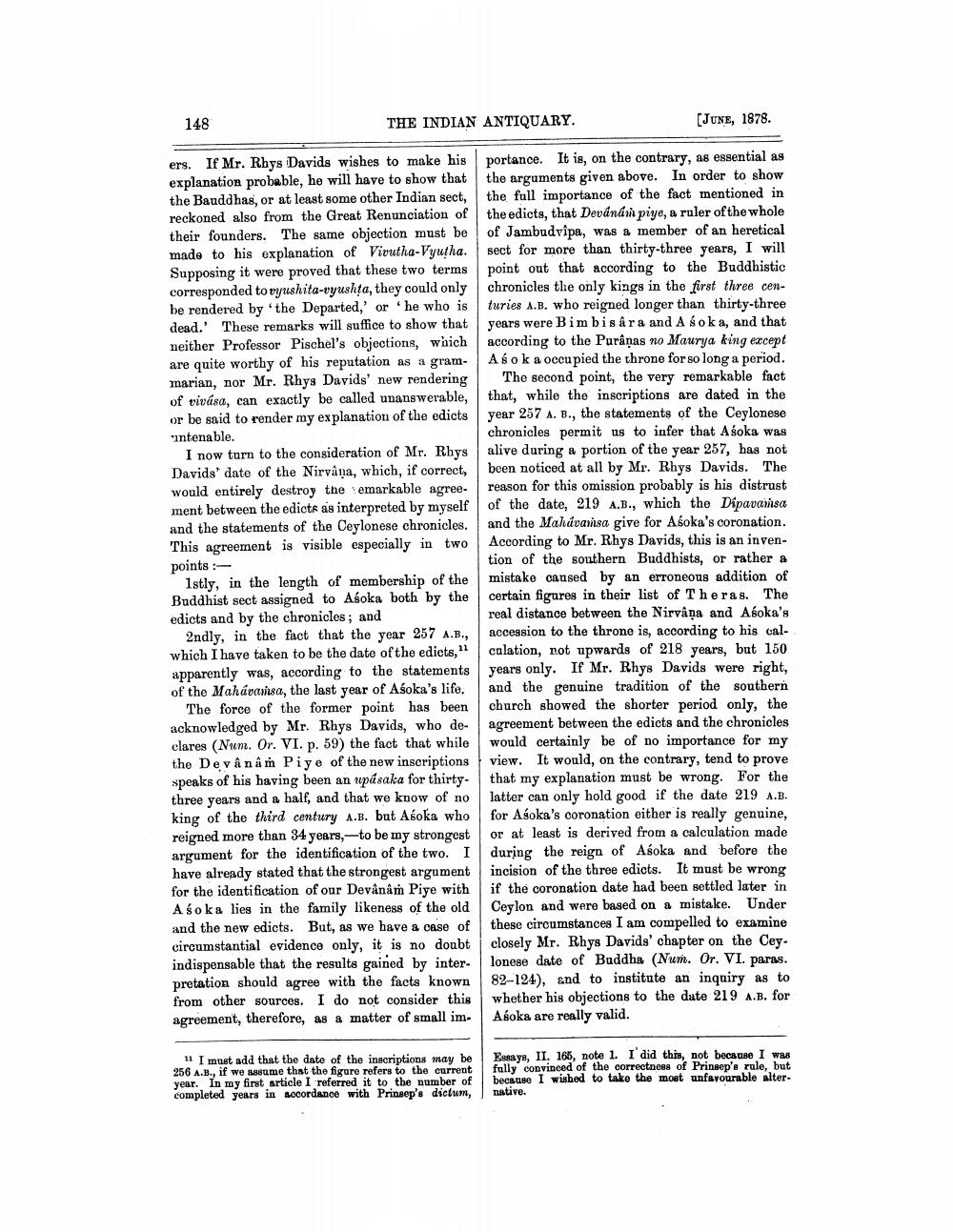________________
148
THE INDIAN ANTIQUARY.
(JUNE, 1878.
ers. If Mr. Rhys Davids wishes to make his portance. It is, on the contrary, as essential as explanation probable, he will have to show that the arguments given above. In order to show the Bauddhas, or at least some other Indian sect, the full importance of the fact mentioned in reckoned also from the Great Renunciation of the edicts, that Devânám piye, a ruler of the whole their founders. The same objection must be of Jambudvipa, was a member of an heretical made to his explanation of Vivutha-Vyutha. sect for more than thirty-three years, I will Supposing it were proved that these two terms point out that according to the Buddhistio corresponded to vyushita-vyushta, they could only chronicles the only kings in the first three cenbe rendered by the Departed,' or 'he who is turies A.B. who reigned longer than thirty-three dead.' These remarks will suffice to show that years were Bimbisâra and A sok a, and that neither Professor Pischel's objections, which according to the Purâņas no Maurya king except are quite worthy of his reputation as a gram- Asok a occupied the throne for so long a period. marian, nor Mr. Rhys Davids' new rendering The second point, the very remarkable fact of vivása, can exactly be called unanswerable, that, while the inscriptions are dated in the or be said to render my explanation of the edicts year 257 A. B., the statements of the Ceylonese untenable.
chronicles permit us to infer that Asoka was I now turn to the consideration of Mr. Rhys alive during a portion of the year 257, has not Davids* date of the Nirvana, which, if correct, boen noticed at all by Mr. Rhys Davids. The would entirely destroy the emarkable agree- reason for this omission probably is his distrust ment between the edicts as interpreted by myself of the date, 219 A.B., which the Dipavainsa and the statements of the Ceylonese chronicles. and the Mahávavisa give for Asoka's coronation. This agreement is visible especially in two According to Mr. Rhys Davids, this is an invenpoints :
tion of the southern Buddhists, or rather a 1stly, in the length of membership of the mistake caused by an erroneous addition of Buddhist sect assigned to Asoka both by the certain figures in their list of Theras. The edicts and by the chronicles; and
real distance between the Nirvana and Asoka's 2ndly, in the fact that the year 257 A.B., accession to the throne is, according to his calwhich I have taken to be the date of the edicts, culation, not upwards of 218 years, but 150 apparently was, according to the statements years only. If Mr. Rhys Davids were right, of the Mahavarisa, the last year of Asoka's life. and the genuine tradition of the southern
The force of the former point has been church showed the shorter period only, the acknowledged by Mr. Rhys Davids, who de- agreement between the edicts and the chronicles clares (Num. Or. VI. p. 59) the fact that while would certainly be of no importance for my the Dev â nám Piye of the new inscriptions view. It would, on the contrary, tend to prove speaks of his having been an upásaka for thirty- that my explanation must be wrong. For the three years and a half, and that we know of no latter can only hold good if the date 219 A.B. king of the third century A.B. but Asoka who for Asoka's coronation either is really genuine, reigned more than 34 years,--to be my strongest or at least is derived from a calculation made argument for the identification of the two. I during the reign of Asoka and before the have already stated that the strongest argument incision of the three edicts. It must be wrong for the identification of our Devånam Piye with if the coronation date had been settled later in A śoka lies in the family likeness of the old Ceylon and were based on a mistake. Under and the new edicts. But, as we have a case of these circumstances I am compelled to examine circumstantial evidence only, it is no doubt closely Mr. Rhys Davids' chapter on the Cey. indispensable that the results gained by inter- lonese date of Buddha (Num. Or. VI. paras. pretation should agree with the facts known 82-124), and to institute an inquiry as to from other sources. I do not consider this whether his objections to the date 219 A.B. for agreement, therefore, as a matter of small im- Asoka are really valid.
11 I must add that the date of the inscriptions may be 256 A.B., if we assume that the figure refers to the current year. In my first article I referred it to the number of completed years in socordance with Prinsep's dictum,
Essays, II. 165, note 1. I did this, not because I WA fully convinced of the correctness of Prinsep's rule, but because I wished to take the most unfavourable alternative.




